
10 Best SaaS Billing Platforms You Can Explore in 2026
Looking for the best SaaS billing platforms? We compared the top 10 for 2026 on features, pricing, and integrations. Find your perfect fit today.
Most SaaS founders pick their billing platform like they pick lunch. They go with what's familiar, what a founder friend recommended, or whatever integrates with Stripe.
Six months later, they’re stuck with billing mistakes, manual fixes, and unhappy customers.
Here's what nobody tells you upfront. The wrong saas billing software doesn't just create headaches. It leaks revenue. Involuntary churn accounts for about 20% to 40% of all churn. That's all to often customers who wanted to stay but left because your billing system failed them.
In 2026, dozens of billing platforms exist. They all promise automation and say they handle subscriptions well. But once you sign up, most deliver something completely different from their promises.
Some tools handle usage-based pricing well but stop working properly when you add big enterprise deals. Others are good with tiered plans but can’t manage mixed or hybrid ones. A few are great for small startups but slow everything down when the company grows.
So which platform actually fits your business?
This guide walks you through 10 saas billing platforms for 2026. For each one, you'll see what it offers, who should use it, the key features, and pricing details.
Why SaaS Businesses Need Billing Software
Lost revenue from billing errors usually sits between 1% to 5% of total revenue. For a SaaS company doing $2M ARR, that's up to $100,000 gone every year because of missed renewals, wrong calculations, or failed payments nobody followed up on.
Customers notice these problems immediately. They get charged twice. Their upgrades don't show up right. Invoices have wrong amounts. And with each error, trust is lost.
Your finance team suffers too. They're stuck manually updating subscriptions, chasing failed payments, fixing errors, and creating invoices instead of doing work that grows the business.
SaaS billing tools solve these problems. They automate recurring charges, handle upgrades and downgrades instantly, retry failed payments on their own, and keep everything accurate without manual work. Your team saves hours every week. Errors drop to almost zero. Revenue becomes easier to predict.
10 Best SaaS Billing Platforms
Here are the top billing platforms that can handle your SaaS business needs in 2026.
1. Outseta
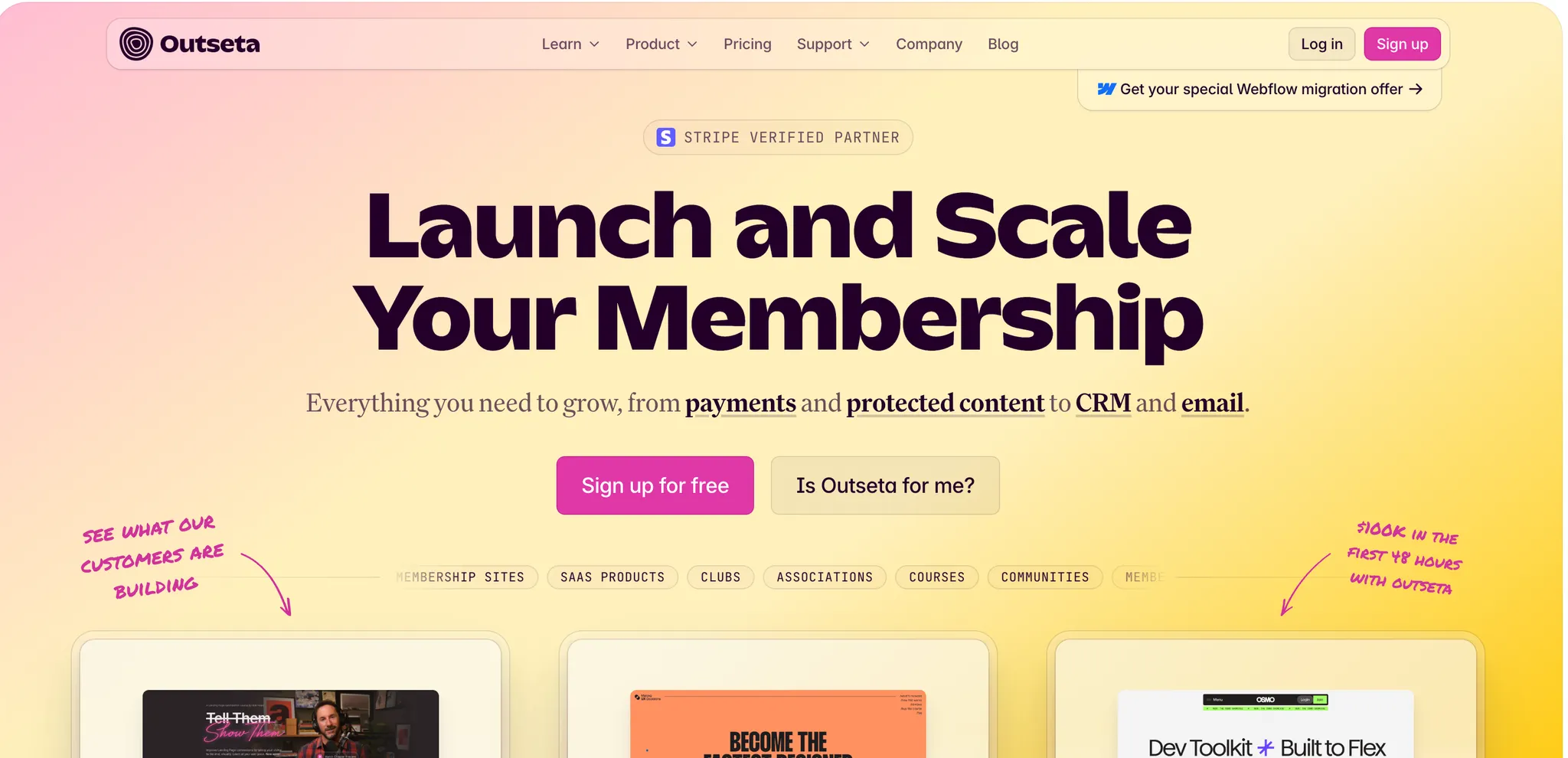
Most SaaS founders end up paying for a slew of different tools: This often looks something like Stripe for billing, Auth0 for authentication, HubSpot for CRM, Mailchimp for emails, and Intercom for support.
Outseta replaces all of them with one platform. You get subscription billing, user authentication, customer management, email marketing, and a help desk working together from day one.
No integration nightmares. No data syncing issues. And you save the extra .7% per transaction in "Stripe Billing" fees that other platforms charge. Outseta gives you everything you need to run a subscription business without the bloat.
Who Is It For
Start-ups and growth-stage SaaS companies who want to launch fast without building a complex tech stack. Bootstrapped founders and solopreneurs needing an all-in-one solution. Membership sites and communities requiring gated content with built-in email marketing.
Key Features
- Complete subscription billing with automatic VAT tax calculation and invoicing
- Built-in authentication with sign-up and login widgets for any website
- Integrated CRM that auto-updates when users sign up or upgrade
- Email marketing with drip campaigns triggered by user behavior
- Full help desk with ticketing system, knowledge base, and live chat
- Deep integration with Framer and Webflow for no-code builders
- Real-time view of customer lifetime value, login activity, and support history
- Unlimited team members across all plans
Pricing
- Founder Plan: $47/month (up to 1,000 contacts, 2% transaction fee)
- Start-up Plan: $87/month (up to 5,000 contacts, 1% transaction fee)
- Growth Plan: $127/month (up to 10,000 contacts, 1% transaction fee)
- 50K Plan: $497/month (up to 50,000 contacts, 1% transaction fee)
Note: Annual plans save you up to 25% compared to monthly billing. Includes a 7-day free trial with no credit card required.
2. Stripe Billing
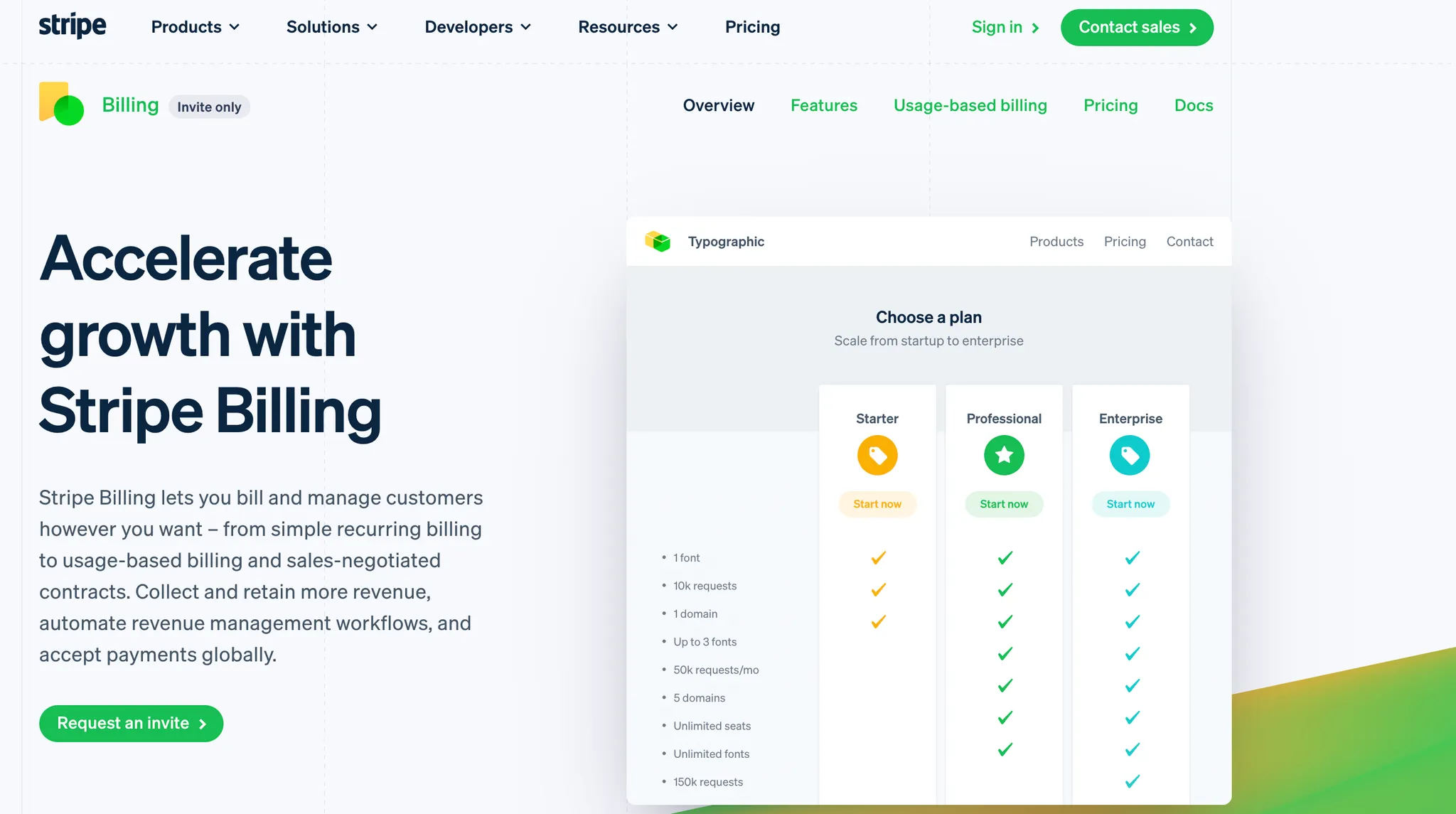
Stripe Billing serves as the industry standard for API-first billing. The platform delivers unmatched flexibility for teams with strong developer resources. You get a powerful billing engine handling everything from simple subscriptions to complex enterprise metered usage. Stripe Billing focuses purely on billing without trying to replace your CRM or support tools.
Who Is It For
Companies with technical teams who can customize their billing setup. Growing SaaS businesses with complex pricing that changes based on usage. Platforms that need to split payments between multiple parties or manage sub-accounts.
Key Features
- Smart payment retries using machine learning to recover 9% more revenue
- Hybrid and usage-based billing with real-time Meters API
- Automated revenue recognition for ASC 606 and IFRS 15 compliance
- Self-serve customer portal for upgrades and invoice management
- Global tax automation for VAT, GST, and sales tax in 100+ countries
- Advanced quotes and ERP connectors
Pricing
- Stripe Billing costs and additional .7% per transaction on top of Stripe normal transaction fees (2.9% + 30¢ per transaction for US based businesses).
- Enterprise: Custom pricing for high-volume merchants
3. Chargebee

Chargebee operates as a revenue growth management platform built for rapidly scaling mid-market and enterprise companies. The platform goes beyond simple billing to function as your financial command center. Chargebee handles complex scenarios like multi-entity management for global subsidiaries, hierarchical billing structures, and deep accounting integrations. The platform shines when your billing needs outgrow basic flat fees and you need sophisticated revenue management tools.
Who Is It For
B2B SaaS companies with sales teams negotiating custom contracts. Global businesses expanding into new regions with multiple tax jurisdictions and currencies. Finance and RevOps teams needing strict compliance and automated revenue recognition.
Key Features
- Advanced revenue recognition that automates ASC 606 and IFRS 15 compliance
- Product Catalog 2.0 for complex bundles and ramp deals without coding
- Smart dunning with Retention module that saves 10-20% of churning customers
- Usage-based and hybrid billing for complex metering models
- Deep Salesforce integration with two-way sync
- Multi-entity management for global operations
Pricing
- Starter Plan: Free for first $250K in cumulative billing (lifetime cap) then 0.75% per transaction
- Performance Plan: $7,188 annually (up to $100K monthly billing)
- Enterprise Plan: Custom pricing with advanced features
4. Recurly
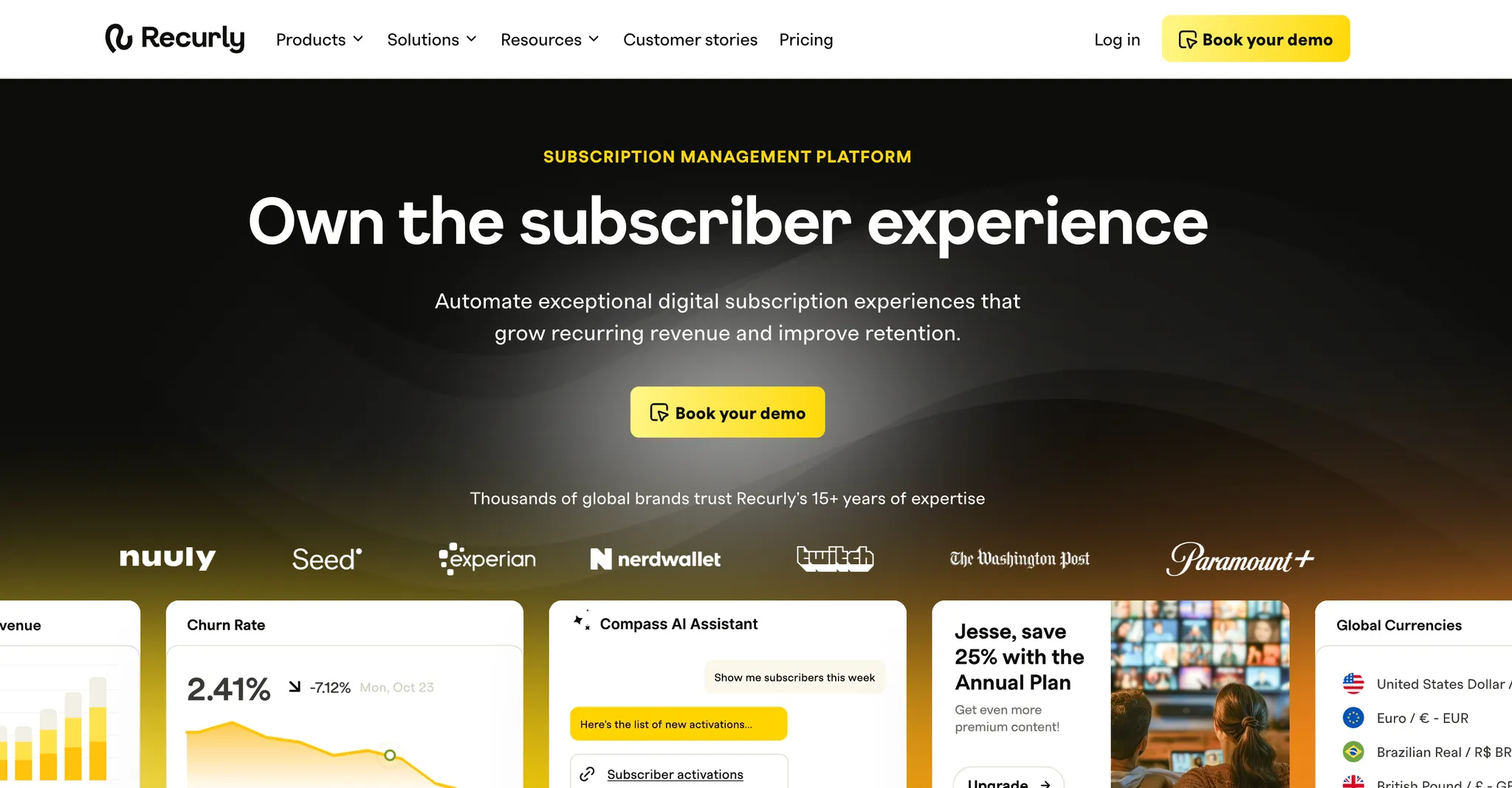
Recurly stakes its claim on one critical problem: retention. The platform uses aggressive machine learning trained on data from companies like Twitch and Paramount+ to recover failed payments that other platforms simply let go. Recurly focuses on keeping the customers you already have by preventing involuntary churn from expired cards and bank declines. The platform becomes essential when customer acquisition costs climb and you need every subscriber counting.
Who Is It For
High-volume B2C subscription businesses in digital media, streaming, and box-of-the-month services. Mid-market SaaS companies processing over $50K monthly who lose 5-10% of revenue to involuntary churn. Marketing-led teams needing insights into cancellation patterns.
Key Features
- Intelligent retries using AI to ping cards at optimal success moments
- Recurly Compass AI agent for retention strategies and pricing experiments
- Wallet-free card updates through Visa/Mastercard networks
- Advanced dunning with personalized email sequences
- Machine learning that recovers 12% of lost revenue on average
- Deep analytics for tracking churn and subscriber behavior
Pricing
You can try it for free for the first three months. Once the trial ends, the company offers custom pricing based on your needs.
5. Zuora
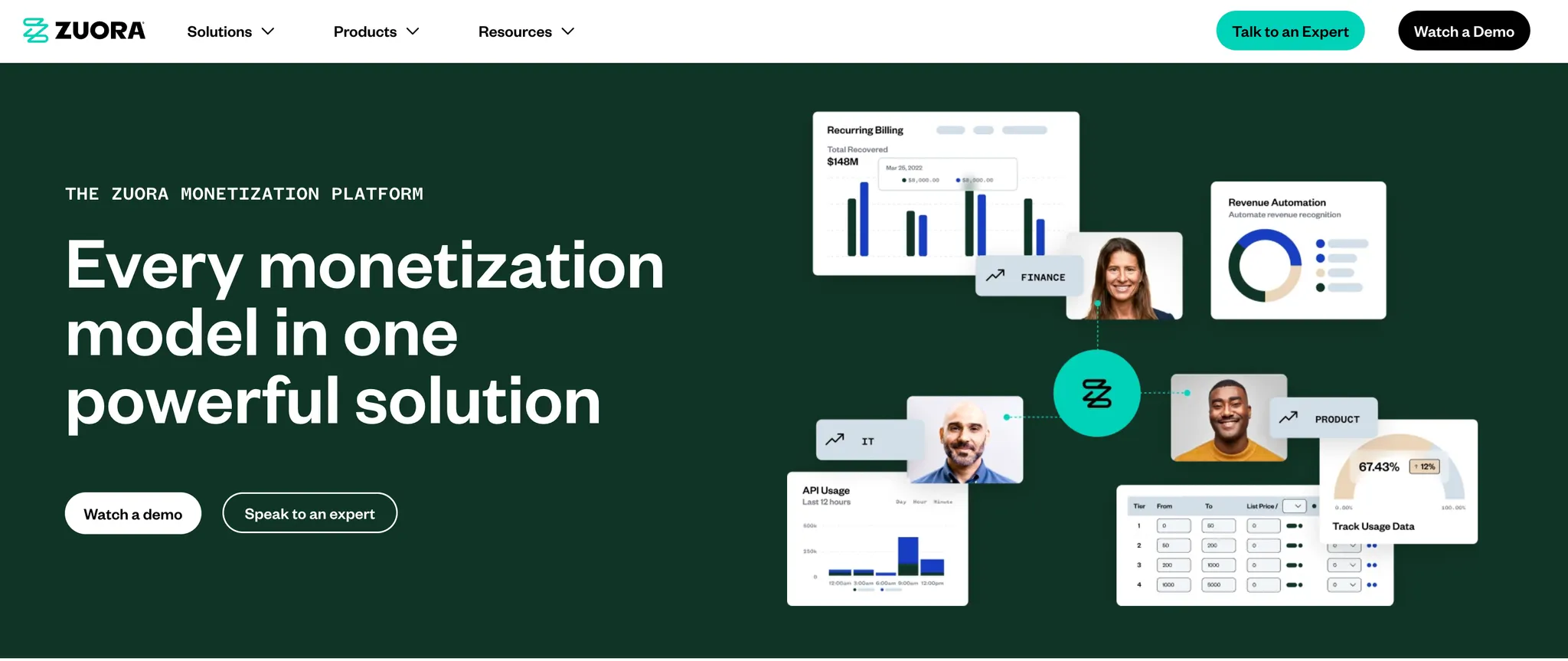
Zuora coined the term "Subscription Economy" and serves as the default choice for large public companies or businesses preparing for an IPO. The platform evolved from a billing tool into a comprehensive monetization platform.
Zuora handles complex revenue operations across global entities, making it the heavy lifter for companies that outgrow Chargebee or Stripe. Major brands like Zoom, General Motors, and The New York Times rely on Zuora for their subscription operations.
Who Is It For
Publicly traded companies or massive organizations needing rigorous governance and audit trails. Businesses combining hardware, software, and services into single subscriptions. Global organizations operating in dozens of countries with multi-currency and multi-entity requirements.
Key Features
- Zuora Revenue for automated ASC 606 and IFRS 15 compliance
- Monetization Catalog for launching pricing strategies without engineering tickets
- Zephr for building dynamic paywalls and personalized offers
- Consumption Metering processing millions of usage events
- Multi-currency and multi-language financial consolidation
- Audit-ready reporting for public company compliance
Pricing
Zuora does not publish public pricing. Contracts typically start around $75,000/year and scale into hundreds of thousands for enterprise packages. Implementation requires 3-6 months with dedicated partners or internal teams.
6. Maxio
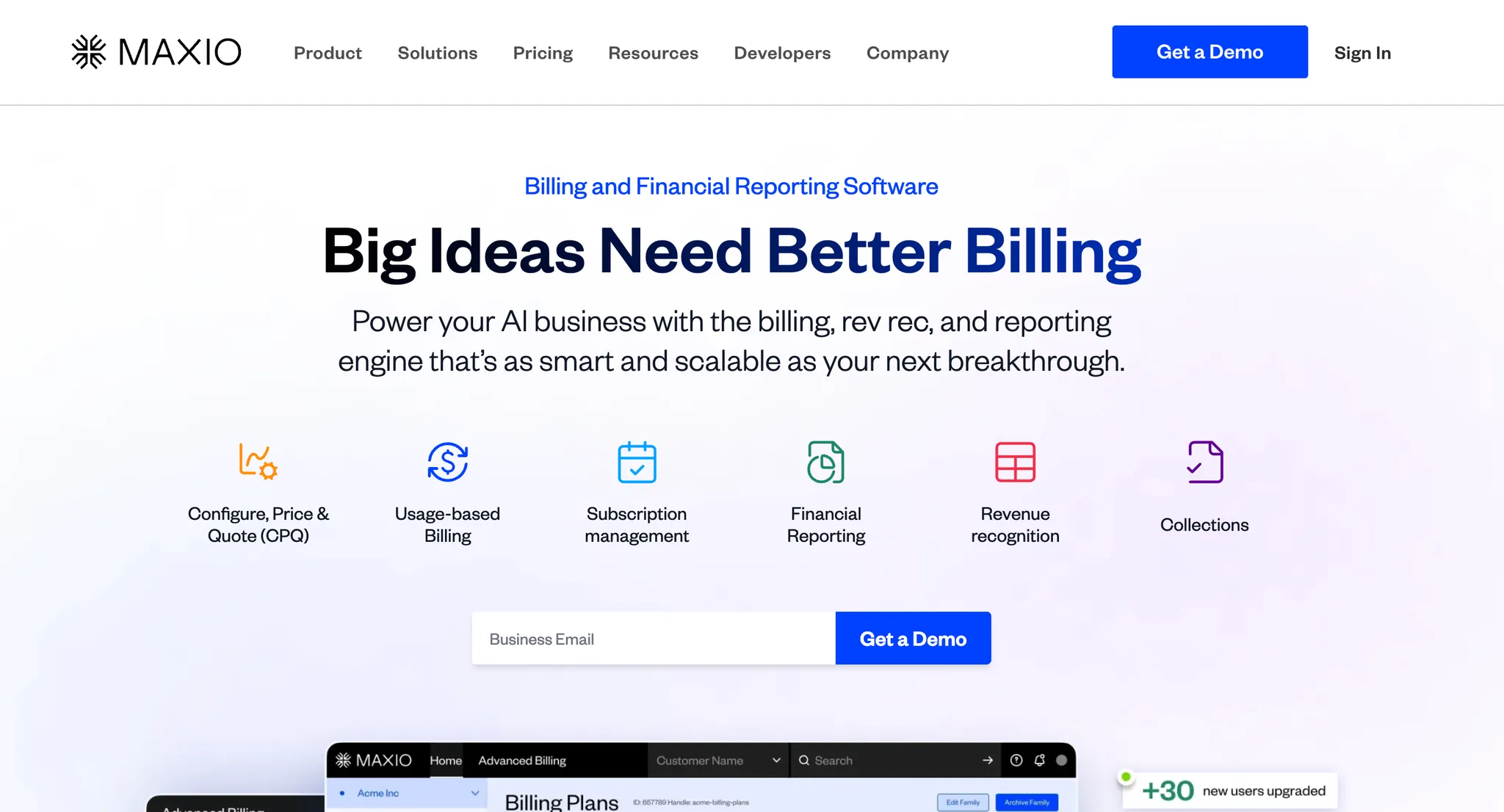
Maxio emerged from the merger between Chargify (billing execution) and SaaSOptics (financial reporting). The platform leads the market for B2B SaaS companies needing audit-ready financials. Maxio handles what happens after you charge a card: revenue recognition, deferred revenue schedules, and deep financial metrics. The platform bridges your billing system and general ledger, making it essential for companies outgrowing simple invoicing.
Who Is It For
B2B SaaS CFOs and finance teams tired of managing ASC 606 revenue recognition in spreadsheets. Sales-led growth companies with complex negotiated contracts and custom terms. Late-stage startups generating $1M-$100M ARR preparing for due diligence or audits.
Key Features
- Advanced ASC 606 and IFRS 15 automated revenue recognition
- Maxio CPQ for generating complex quotes that become instant subscriptions
- Hybrid and usage-based billing with elastic metering capabilities
- Investor-grade reporting with SaaS Magic Number and cohort retention
- Automatic split between bookings and recognized revenue
- Native integrations with QuickBooks, Xero, NetSuite, and Intacct
Pricing
- Build Plan: Free 30-day sandbox for testing
- Grow Plan: $599/month (up to $100K monthly billing volume)
- Scale Plan: Custom pricing for higher volumes
7. Paddle

Paddle takes a completely different approach by acting as a Merchant of Record (MoR). Technically, Paddle sells your product to the customer, not you. This legal distinction means Paddle takes 100% liability for global taxes, fraud, and compliance off your shoulders. For SaaS companies selling into 100+ countries, this eliminates the need to register and remit taxes across jurisdictions.
Who Is It For
Global SaaS startups with small teams but worldwide customer bases. Digital product sellers offering downloads, courses, or simple subscriptions. Bootstrappers who want to avoid the complexity of international tax compliance.
Key Features
- Tax automation where Paddle files and remits taxes for you
- Paddle Retain (formerly ProfitWell) to defend against churn automatically
- Localized payment methods including Pix, Alipay, and iDeal
- Hybrid billing supporting usage-based alongside standard subscriptions
- Complete fraud protection and payment processing
- Single wire transfer with all taxes handled behind the scenes
Pricing
- Pay-As-You-Go: 5% + $0.50 per transaction (includes all fees, no monthly charges)
8. Zoho Billing

Zoho Billing (formerly Zoho Subscriptions) expanded beyond recurring subscriptions to become a unified platform handling one-time invoices, project billing, and expense tracking. The platform's biggest strength comes from the Zoho ecosystem integration. If you already use Zoho CRM or Zoho Books, this tool plugs in instantly and shares data across your entire business without any coding required.
Who Is It For
Budget-conscious startups looking for affordable feature-rich billing software. Consultancies and agencies mixing retainer clients with project-based work. Businesses already using Zoho products who want seamless data flow.
Key Features
- Unified billing handling both one-time and recurring charges on single invoices
- Global tax compliance with built-in US Sales Tax, VAT, and GST handling
- White-labeled client portal for self-service subscription management
- Apple Pay and Google Pay integration for mobile checkout
- Metered billing for usage-based pricing models
- Automated dunning management for failed payment recovery
Pricing
- Standard Plan: $29/month (3 users, 500 customers, multi-currency support)
- Premium Plan: $69/month (unlimited customers, 10 users, advanced features)
- Custom Plan: Contact sales for enterprise needs
9. FastSpring
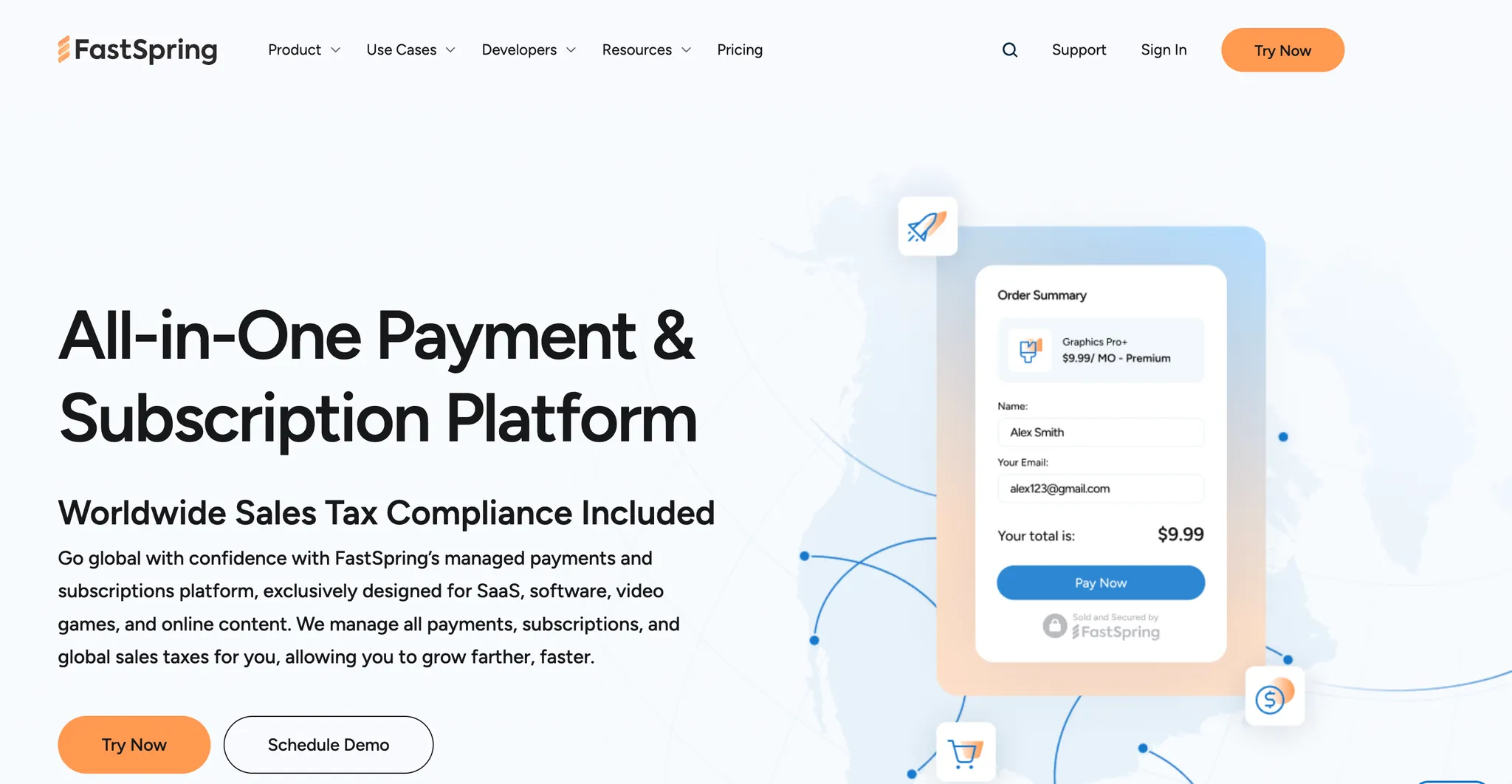
FastSpring serves as the veteran heavyweight Merchant of Record for established software companies. The platform bridges the gap between self-serve B2C checkout and high-touch B2B sales. FastSpring handles your entire billing back office including global tax collection, fraud prevention, and remittance. You can sell in 200+ regions without setting up local bank accounts or dealing with VAT/GST liability.
Who Is It For
Global software vendors selling digital downloads or SaaS subscriptions cross-border. Companies running hybrid B2B/B2C models with both instant checkout and quote-based sales flows. Legacy desktop software companies transitioning to recurring SaaS models.
Key Features
- Interactive quotes allowing prospects to adjust quantities and pay instantly
- Global tax filing where FastSpring collects, files, and remits all taxes
- Contextual checkout overlaying your site so customers never leave your domain
- Risk Guardian fraud detection blocking fraudulent transactions automatically
- Support for both one-time licenses and recurring subscriptions
- Optimized conversion flows for both B2C and enterprise B2B sales
Pricing
FastSpring operates on custom pricing based on your transaction volume. Rates typically start around 5.9% + $0.95 per transaction for lower volumes, scaling down as volume increases. All payment processing, fraud protection, tax compliance, and subscription management are bundled into the rate.
10. GoCardless

GoCardless focuses on bank payments (Direct Debit) instead of credit cards. The platform pulls payments directly from customer bank accounts, avoiding high card fees and expiration-related churn. GoCardless typically integrates alongside tools like Zuora or Xero to handle the bank debit portion of your payment stack.
Who Is It For
High-ticket B2B SaaS companies charging $5,000+ monthly who want to avoid steep credit card fees. European and UK businesses where Direct Debit is the preferred payment method. Companies tired of losing customers due to expired credit cards.
Key Features
- Instant Bank Pay using Open Banking for immediate payment confirmation
- Success+ machine learning recovering 70% of failed payments automatically
- Global bank network unifying ACH, Bacs, SEPA, and BECS through one API
- Variable recurring payments for usage-based billing from bank accounts
- Capped transaction fees making large payments extremely cost-effective
- Protect+ anti-fraud protection with custom branding on bank statements
Pricing
- Standard Plan: 1% + £0.20/$0.40 per transaction (capped at £4/$4/€2)
- Advanced Plan: 1.25% + £0.20/$0.40 (capped at £5/$5/€2.50, includes Success+)
- Pro Plan: 1.4% + £0.20/$0.40 (capped at £5.60/$5.60/€3.50, includes Protect+)
Note: International payments charged at 2% + £0.20/$0.40 per transaction.
SaaS Billing Tools: Quick Comparison
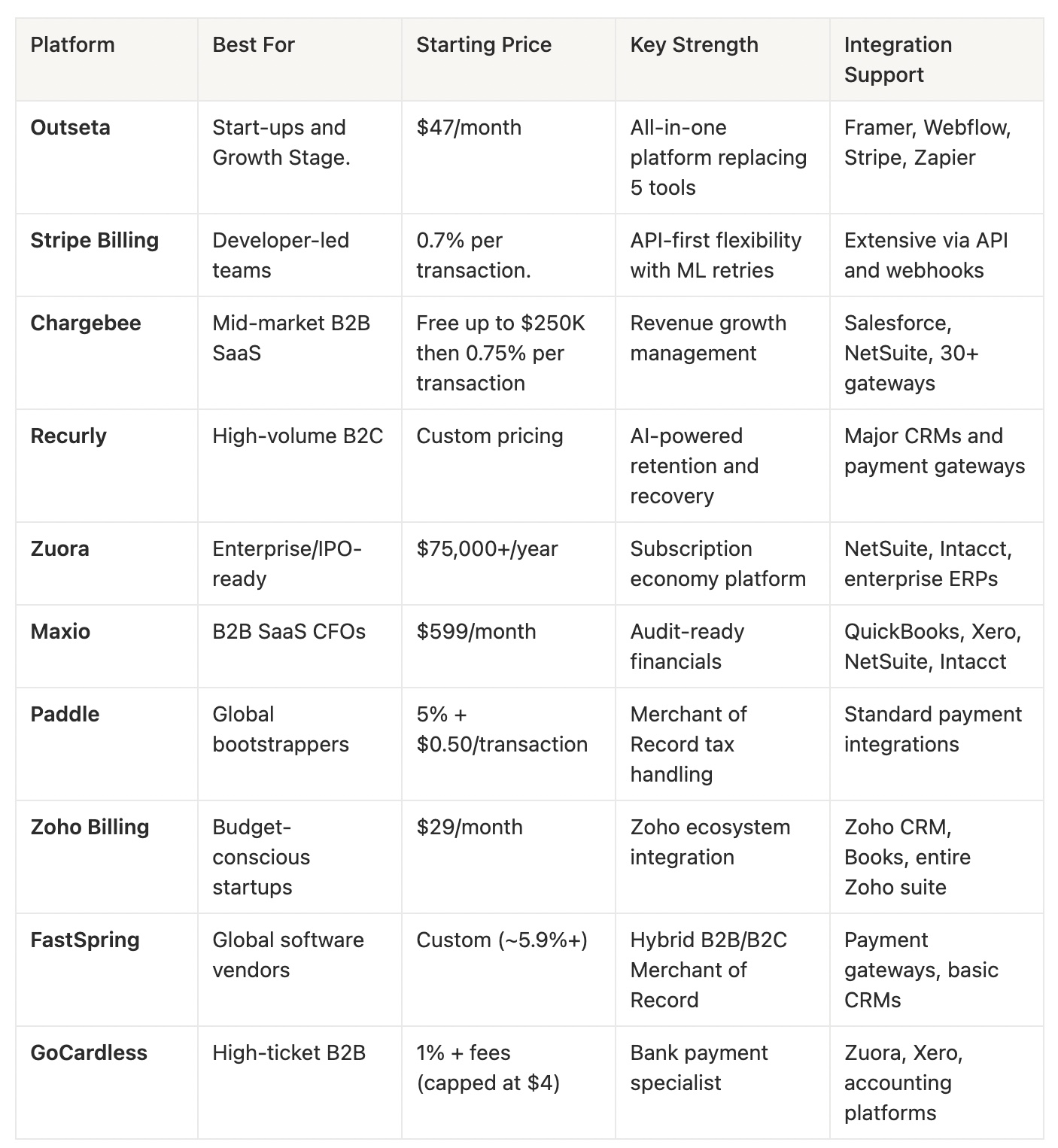
How to Choose the Right SaaS Billing Software for Your Business?
Switching billing platforms takes time and effort. But outdated software quietly damages your revenue and blocks growth. Here's how to choose wisely

Define Your Actual Needs
Map what your business truly requires. Do you need full subscription management or just invoicing? Operating across multiple countries? What's your billing volume and growth rate? Need revenue recognition for compliance? List your must-haves versus nice-to-haves before comparing options.
Match Pricing to Reality
Every platform charges differently. Some take percentage fees, others charge flat rates. A platform charging 5% might cost less than one at 1% if it eliminates hiring specialists. Calculate total cost honestly, including transaction fees and potential overages.
Check Integration Capabilities
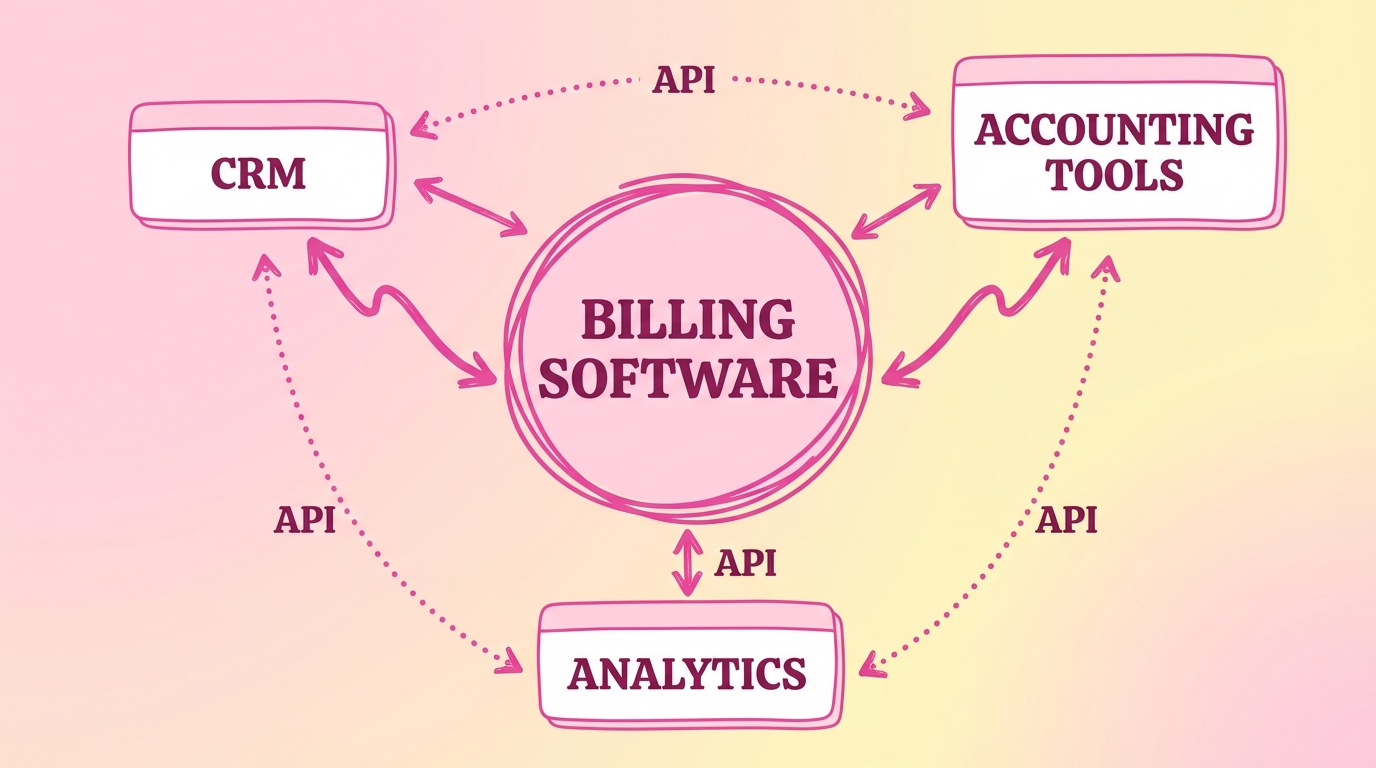
Your billing software must connect with your CRM, accounting tools, and analytics platforms. Look for open APIs and pre-built integrations. The best platforms become part of your revenue engine, not just another disconnected tool.
Test Before Committing
Use free trials. Set up test subscriptions, process payments, see if the interface works. Most mistakes happen because teams skip this step.
Conclusion
The right saas billing platform makes or breaks your revenue operations. Every platform on this list solves real problems, but choosing wrong means migration headaches later.
Key Takeaways:
- Bootstrapped startups need all-in-one simplicity: Outseta, Zoho Billing
- Growth-stage companies require flexibility: Outseta, Stripe Billing, Chargebee
- Enterprise operations demand compliance: Zuora, Maxio
- Global sellers save with Merchant of Record: Paddle, FastSpring
- High-ticket B2B cuts costs with bank payments: GoCardless
- Usage-based pricing needs sophisticated metering: Stripe, Chargebee, Maxio
Ready to Simplify Your Tech Stack?
If you're building a SaaS or membership business, Outseta offers a complete solution in one platform. You get subscription billing, authentication, CRM, email marketing, and help desk without juggling multiple tools.
Save the 0.7% Stripe Billing fee, access unlimited team members, and launch faster. No integration headaches. No data syncing issues.
Start your 7-day free trial → Outseta.com
Choose the platform that fits your business and start growing without the billing bottlenecks.

